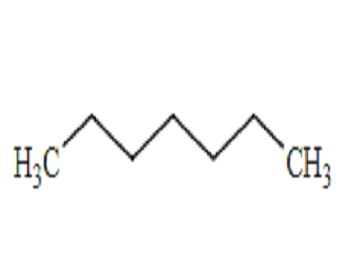English Synonyms
Aliphatic hydrocarbon;Dipropylmethane;Eptani;Exxsol heptane;Gettysolve-C;Heptan;heptane(n-heptane);Heptanen
Heptane Properties
| Melting Point | −91 °C(lit.) |
| Boiling Point | 98 °C(lit.) |
| Density | 0.684 g/mL at 20 °C |
| Vapor Density | 3.5 (vs air) |
| Vapor Pressure | 40 mm Hg ( 20 °C) |
| Refractive Index | n20/D 1.397
|
| Flash Point | 30 °F |
| Storage Condition | Store at +5°C to +30°C. |
| Solubility | Miscible (lit.) in Acetone |
| Acidity Coefficient (pKa) | >14 (Schwarzenbach et al., 1993) |
| Form | Liquid |
| Color | ≤10(APHA) |
| Proportion | 0.684 (20/4℃) |
| Relative Polarity | 0.012 |
| Odor | Gasoline Smell |
| Odor Threshold | 0.67ppm |
| Explosive Limit | 1-7%(V) |
| Water Solubility | Practically Insoluble |
| Maximum Wavelength (λmax) | λ: 200 nm Amax: ≤1.0 λ: 225 nm Amax: ≤0.10 λ: 250 nm Amax: ≤0.01 λ: 300-400 nm Amax: ≤0.005 |
| Dielectric Constant | 1.9(20℃) |
| Stability | Stable. Incompatible with Oxidants, Chlorine and Phosphorus. Highly Flammable. Can Easily Form Explosive Mixtures with Air. |
Uses and Synthesis of Heptane
Introduction
N-Heptane Has Nine Isomers, Among Which N-Heptane [ch3(Ch2)5ch3] Is the Most Important. It Is a Colorless Flammable Liquid. It Is Almost Insoluble in Water, Slightly Soluble in Alcohol, And Soluble in Ether and Chloroform. Its Vapor Forms an Explosive Mixture with Air, With an Explosion Limit of 1.0-6.0% (Volume). It Is Separated from Petroleum Fractions. It Vibrates Violently When It Burns and Explodes in the Cylinder. Its Octane Number Is Set as Zero. Mixtures of Various Proportions with *iso-Octane (Octane Number Is Set as 100) Are Often Used as Standards for Determining the Octane Number of Gasoline.
Application
N-Heptane Is a Typical Non-polar Solvent, Commonly Used as a Standard for Determining Octane Number, An Anesthetic, Organic Synthesis Raw Material, Etc. It Is Also Widely Used in the Pharmaceutical, Pesticide, Rubber Synthesis, Chemical Fiber Synthesis, Reagents, Electronic Cleaning and Other Industries. N-Octane Is Used as a Solvent and Chromatographic Analysis Standard Substance, And Is Also Used in Organic Synthesis. With the Rapid Development of Related Industries Such as Chemical, Pharmaceutical, And Electronic, My Country's Demand for N-Heptane Will Increase Year by Year, Especially High-Purity N-Heptane Has a Broad Market Prospect.
Use
N-Heptane Is Mainly Used as a Standard and Solvent for Octane Number Determination, As Well as for Organic Synthesis and the Preparation of Experimental Reagents. N-Heptane Is One of the Most Widely Used Hydrocarbon Solvents in Industry Today. It Is Used as an Extraction Solvent for Animal and Vegetable Oils and Fats, As a Quick-Drying Rubber Adhesive, And as a Rubber Solvent. It Is Also Used in the Manufacture of Cosmetics and as a Solvent for Cleaning Coatings, Paints, Quick-Drying Inks, And Printing Machine Parts. Industrial-Grade N-Heptane Is Mostly Obtained by Separation of Petroleum Fractions and Has a Low Purity.
Production Method
The Content of N-Heptane in the Fraction of Platinum Reforming Raffinate (93-102℃) Is More Than 57%. The N-Alkanes in the Fraction Are Adsorbed by 5a Molecular Sieve Gas Phase, And Then Separated by Steam Desorption to Obtain N-Alkanes. After Nickel Catalytic Hydrogenation, A Small Amount of N-Olefins Are Saturated and Converted into N-Alkanes, And the Iodine Value Is Reduced to Below 0.1g Iodine/100g to Be Qualified. Finally, Standard N-Heptane with a Purity of 99.9% Is Obtained by Distillation. Industrial-Grade N-Heptane Can Also Be Purified by Concentrated Sulfuric Acid Washing, Methanol Azeotropic Distillation and Other Methods.


